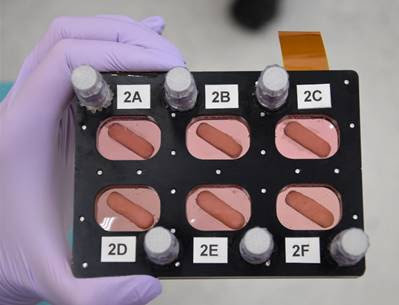'Bone Glue' Experiments on the ISS Test Possible Treatment for Osteoporosis
A new experiment on the International Space Station is testing an innovative "bone glue" that might help reverse osteoporosis, the crippling bone disease that affects over 200 million people worldwide. Additionally, the glue — called Tetranite — could be used to repair bone loss in astronauts on long-duration spaceflights.
"If we can show that our material stimulates the production of new bone in the space environment, that will have a translational value back on Earth, that it could be used to someday treat patients with osteoporosis," said Brian Hess, founder and CEO of Launchpad Medical, which created the glue. "But it could also be a material to help treat astronauts from the effects of deep space travel. That's obviously a secondary reason of why we are studying this in space, but it is an interesting duality."
A SpaceX Dragon capsule launched from Cape Canaveral on Dec. 15 delivered the experiment to the ISS. Astronauts have now been working with cell culture tests for the Tetranite experiment in the space station's Microgravity Science Glovebox, which provides a sealed environment and built in gloves for conducting science and technology experiments. At the conclusion of the 20-day tests in space, the experiment will be frozen and sent back to Earth in January when the Dragon is scheduled to depart the station with more than 3,600 pounds of research, hardware, and crew supplies.
NASA has long been studying the progressive loss of bone mass since it is a known serious side-effect of extended spaceflight. On Earth, NASA has done bedrest studies where subjects stay in bed for 90 days, simulating the effects of microgravity where the absence of Earth's gravity disrupts the process of bone maintenance in its major function of supporting body weight.
"The microgravity environment puts very low force on your bones," Hess told Seeker. "And the way your skeleton responds is that if you don't use it, you lose it. Astronauts lose up to 2 percent of their bone mass per month."
RELATED: The ISS Bacterial Community Resembles What You'd Find in Your Home
Normal bones are constantly regenerating, with bone cells called osteoclasts breaking down bone and other cells called osteoblasts creating new bone. Osteoclasts and osteoblasts usually coordinate well over a person's lifetime for good bone health.
Breaking space news, the latest updates on rocket launches, skywatching events and more!
Previous studies have shown that the absence of gravitational forces causes both an increase in bone resorption by osteoclasts and a decrease in osteoblast cellular integrity. This is also what happens with osteoporosis. And since osteoporosis affects so many people on Earth, researchers hope that solving the riddle of bone loss in space will reveal important clues about what causes osteoporosis and other bone disorders here on Earth.
Hess said space is the perfect environment to study key findings in how Tetranite works with patients who have osteoporosis, since it provides conditions that aren't available on Earth.
The experiment focuses on how osteoblasts grow in microgravity in the cell cultures in the presence of Tetranite and without the material. It will also test commercially available bone graft material. A duplicate of the experiment is being conducted on Earth.
If the results are promising, Hess hopes to do longer tests on the ISS using the space station's rodent research facility. He said that his company has successfully used Tetranite in rodent tests on Earth to stabilize dental implants and other tests on cow bones to determine the strength of the bond Tetranite provides.
"We currently are doing testing on animals, and our next major milestone would be to get into human clinical trials for study, which we hope to be able to do in the next year or so," Hess said.
In addition to bone fracture repair, the company sees a potential for multiple orthopedic uses such as spinal fusion and dental repair.
RELATED:The Human Body Isn't Ready For Mars
Hess said he was inspired to create a bone glue when he worked with orthopedic surgeons as part of his previous job as an engineer of medical devices.
"One thing I realized is that surgeons — although they are highly skilled and extremely talented — are like carpenters, putting people back together from muscular-skeletal injuries," Hess said. "But in a way they are using old technology, using screws to put bones of the human body back together. I knew there had to be a less invasive, more elegant way to do this."
Hess said surgeons have been looking for a glue that was injectable, that worked in liquids, and was biocompatible — three problems that have been difficult to solve.
"So far, no one has been able to do all three of those things, but we think we have it," Hess said.
Tetranite was reverse engineered from what sea barnacles secrete to bond themselves to underwater structures and is made from calcium and amino acids.
"The calcium and the amino acids react to form a gluey substance that hardens," Hess said. "Over time the glue is resorbed by the body. What is unique about our material is that we believe it not only facilitates a hospitable environment for cells to grow and proliferate, but could stimulate activity of the osteoblast cells so there is a net increase in bone mass."
Hess said the compound's simple chemistry — small molecules from animal derived proteins — means a body doesn't reject it. But because it's synthetic, it can be scaled up at low cost.
Hess named his company Launchpad Medical not because he thought he'd be doing experiments in space one day, but because he wanted to help people "launch" new medical innovations.
But still, the chance for his company to conduct experiments in space provides a unique opportunity.
"The ISS is an exciting resource," Hess said, "but it seems most people don't really appreciate what is going on up there."
Originally published on Seeker.

Nancy Atkinson is a science journalist and author who works to tell the stories of people involved in space exploration and astronomy. She has written two books about the people behind NASA projects like the Apollo missions and the robotic rovers exploring our solar system, and hosted/worked on several astronomy
podcasts. A writer for Universe Today since 2004, Atkinson's work can also be found at The Planetary Society and Ad Astra, the magazine of the National Space Society. Other work can be found at Seeker, New Scientist, Wired.com, Space.com, NASA’s Astrobiology Magazine, Space Times Magazine, and several newspapers in the Midwest.


